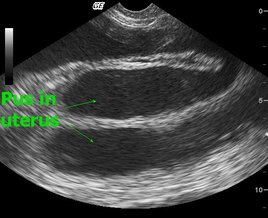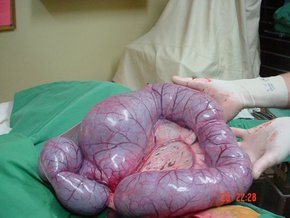The abnormal thickening (pyometra) of the uters' lining can occur in dogs at any age, although it is more common in dogs that are six years of age or older. Cystic endometrial hyperplasia, meanwhile, is a medical condition characterized by the presence of pus-filled cyst inside the dog's uterus, causing the endometrium to enlarge (also known as hyperplasia).
Prognosis is often positive for both conditions; however, if the dog's cervix is closed, it can be a life threatening condition requiring immediate medical attention.
Symptoms and Types
Signs may include:
Causes
One of the known causes of this condition in dogs is repeat exposure to estrogen andprogesterone. The formation of cystic endometrial hyperplasis is often progressive, often following the development of a thickened uterine lining.
Intact older female dogs that have never given birth are at a higher risk of developing pyometra or cystic endometrial hyperplasia.
Diagnosis
Your veterinarian will perform an examination to review the type and severity of your dog’s discharge, as well as to view whether the cervix is open or closed. X-rays and ultrasounds will be used detect the size of the uterus, and to determine if the dog is pregnant.
Treatment
In many cases, treatment for pyometra will be given on an outpatient basis. However, if the cervix is closed, the condition can be life threatening and immediate action will be required. The preferred treatment for this medical condition is a hysterectomy -- the removal of the dog's ovaries and uterus. Other options are available, but at a higher risk to the animal's wellbeing; these are only recommended for dogs with a high breeding value.
A lavage of the uterus and surrounding areas will be performed to remove the pus and fluids, and to support the healing process. Antibiotics are often administered to fight off infection. Prostaglandins, meanwhile, are administered to control the dog's cell growth and control hormone regulation, and to cause the smooth muscles in the dog's body to contract.
Living and Management
Your dog will be released from medical care once its uterus has returned to normal size and there are no signs of fluids. Antibiotics should be administered for several weeks to prevent infection. It is normal for vaginal discharge to continue until the healing process is complete.
Prevention
Allowing your dog to go through its heat (estrus) cycles without being bred has been shown to increase the incidence of pyometra. Therefore, spaying your dog (or removing its ovaries) is the best form of prevention.
Prognosis is often positive for both conditions; however, if the dog's cervix is closed, it can be a life threatening condition requiring immediate medical attention.
Symptoms and Types
Signs may include:
- Abdominal distention (from an enlarged uterus)
- Vulvar (vaginal) discharge
- Closed cervix
- Lethargy
- Depression
- Lack of appetite
- Vomiting
- Frequent urination
Causes
One of the known causes of this condition in dogs is repeat exposure to estrogen andprogesterone. The formation of cystic endometrial hyperplasis is often progressive, often following the development of a thickened uterine lining.
Intact older female dogs that have never given birth are at a higher risk of developing pyometra or cystic endometrial hyperplasia.
Diagnosis
Your veterinarian will perform an examination to review the type and severity of your dog’s discharge, as well as to view whether the cervix is open or closed. X-rays and ultrasounds will be used detect the size of the uterus, and to determine if the dog is pregnant.
Treatment
In many cases, treatment for pyometra will be given on an outpatient basis. However, if the cervix is closed, the condition can be life threatening and immediate action will be required. The preferred treatment for this medical condition is a hysterectomy -- the removal of the dog's ovaries and uterus. Other options are available, but at a higher risk to the animal's wellbeing; these are only recommended for dogs with a high breeding value.
A lavage of the uterus and surrounding areas will be performed to remove the pus and fluids, and to support the healing process. Antibiotics are often administered to fight off infection. Prostaglandins, meanwhile, are administered to control the dog's cell growth and control hormone regulation, and to cause the smooth muscles in the dog's body to contract.
Living and Management
Your dog will be released from medical care once its uterus has returned to normal size and there are no signs of fluids. Antibiotics should be administered for several weeks to prevent infection. It is normal for vaginal discharge to continue until the healing process is complete.
Prevention
Allowing your dog to go through its heat (estrus) cycles without being bred has been shown to increase the incidence of pyometra. Therefore, spaying your dog (or removing its ovaries) is the best form of prevention.



 RSS Feed
RSS Feed
